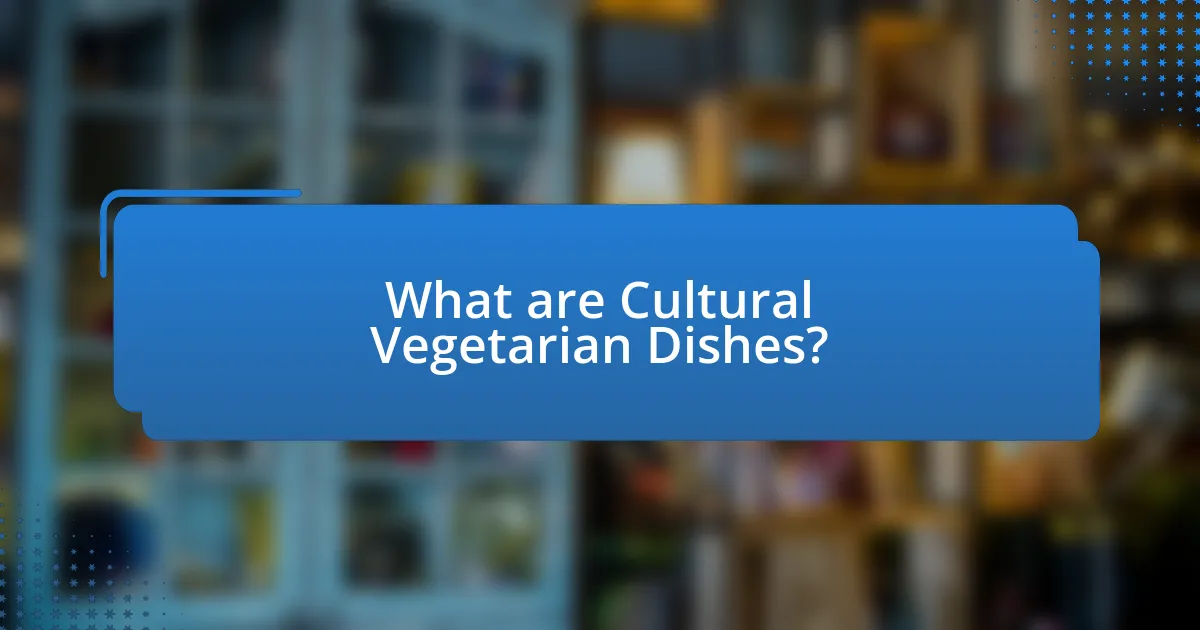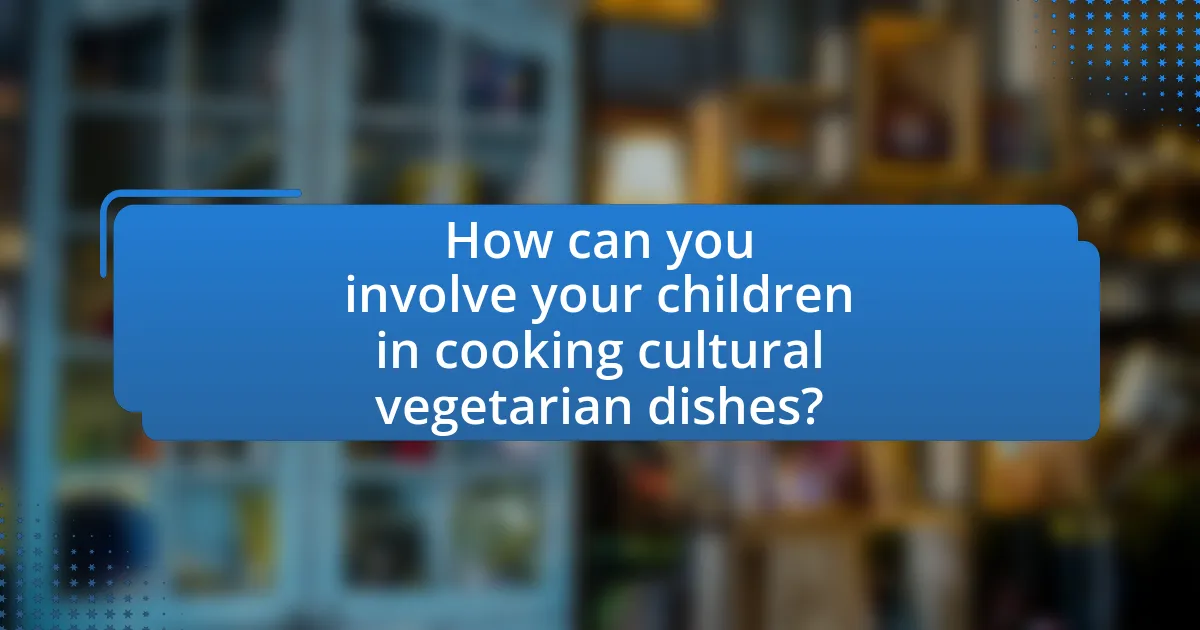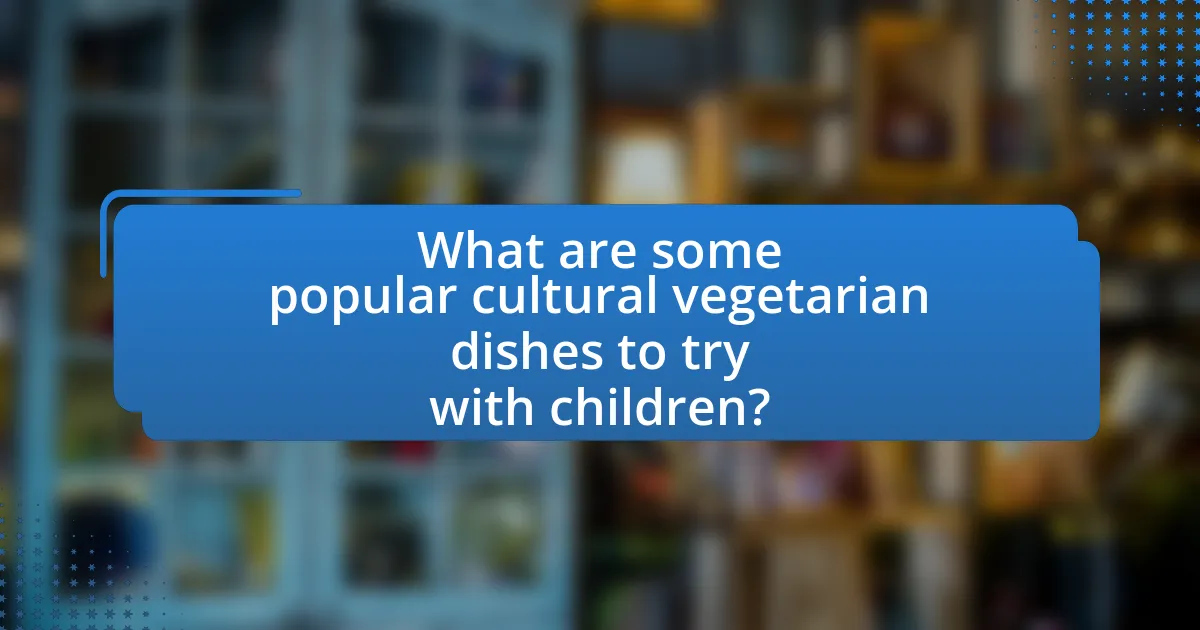Cultural vegetarian dishes are traditional meals from various cultures that exclude meat and fish, emphasizing plant-based ingredients. This article explores the diversity of these dishes across different regions, highlighting examples from Indian, Mediterranean, and East Asian cuisines. It discusses the importance of involving children in cooking these dishes to promote cultural awareness, enhance culinary skills, and foster healthy eating habits. Additionally, it provides practical tips for engaging children in the kitchen, adjusting recipes to suit their tastes, and ensuring a safe cooking environment. The article emphasizes the educational benefits of exploring cultural vegetarian cuisine with children, making it a valuable resource for families.

What are Cultural Vegetarian Dishes?
Cultural vegetarian dishes are traditional meals from various cultures that do not include meat or fish, focusing instead on plant-based ingredients. These dishes often reflect the agricultural practices, religious beliefs, and culinary traditions of specific regions. For example, Indian cuisine features dishes like dal (lentils) and paneer tikka, while Mediterranean cuisine includes dishes such as falafel and hummus, showcasing the use of legumes, grains, and vegetables. The diversity of cultural vegetarian dishes highlights the global emphasis on vegetarianism, with many cultures incorporating these meals into their daily diets for health, ethical, or religious reasons.
How do cultural vegetarian dishes vary across different regions?
Cultural vegetarian dishes vary significantly across different regions due to local ingredients, traditions, and culinary practices. For instance, in India, vegetarian cuisine is heavily influenced by religious beliefs, leading to a diverse array of dishes such as paneer tikka and dal makhani, which utilize legumes and dairy products. In contrast, Mediterranean regions emphasize fresh vegetables and grains, with dishes like Greek spanakopita and Italian caponata showcasing local produce and herbs. Additionally, East Asian cultures, such as in Japan, feature vegetarian options like vegetable tempura and miso soup, often highlighting seasonal ingredients and umami flavors. These regional variations reflect the unique agricultural practices, cultural histories, and dietary restrictions prevalent in each area, demonstrating how geography and culture shape vegetarian culinary traditions.
What are some examples of vegetarian dishes from various cultures?
Some examples of vegetarian dishes from various cultures include Indian Chana Masala, which is a spiced chickpea curry; Italian Caprese Salad, made with fresh mozzarella, tomatoes, and basil; and Mexican Enchiladas with cheese and vegetables. Additionally, Middle Eastern Falafel, which consists of deep-fried chickpea balls, and Japanese Vegetable Tempura, featuring battered and fried seasonal vegetables, are also notable vegetarian options. Each of these dishes reflects the culinary traditions and ingredients unique to their respective cultures, showcasing the diversity of vegetarian cuisine worldwide.
How do ingredients differ in cultural vegetarian cooking?
Ingredients in cultural vegetarian cooking differ significantly based on regional availability, culinary traditions, and cultural preferences. For instance, Indian vegetarian cuisine prominently features lentils, chickpeas, and a variety of spices, reflecting the country’s agricultural practices and religious beliefs that promote vegetarianism. In contrast, Mediterranean vegetarian dishes often include olives, tomatoes, and grains like couscous, influenced by the climate and agricultural history of the region. Additionally, East Asian vegetarian cooking frequently incorporates tofu, rice, and a range of vegetables, shaped by local dietary customs and the use of umami flavors. These variations illustrate how cultural contexts dictate the selection and preparation of vegetarian ingredients, resulting in diverse culinary expressions across the globe.
Why is it important to explore cultural vegetarian dishes with children?
Exploring cultural vegetarian dishes with children is important because it promotes cultural awareness and appreciation. Engaging children in the preparation and consumption of diverse vegetarian cuisines fosters an understanding of different cultures and traditions, which is essential in a globalized world. Research indicates that early exposure to various foods can enhance children’s willingness to try new foods and develop healthier eating habits. For instance, a study published in the journal “Appetite” found that children who are introduced to a variety of foods are more likely to accept and enjoy them, leading to a more balanced diet.
What educational benefits do children gain from cooking cultural dishes?
Children gain several educational benefits from cooking cultural dishes, including enhanced cultural awareness, improved math and science skills, and increased nutritional knowledge. Engaging in the preparation of cultural recipes exposes children to diverse traditions and practices, fostering an appreciation for different cultures. This hands-on experience also involves measuring ingredients and understanding cooking processes, which reinforces mathematical concepts such as fractions and volume, as well as scientific principles like chemical reactions during cooking. Furthermore, learning about the ingredients used in various cultural dishes promotes nutritional literacy, helping children make informed food choices.
How can exploring these dishes promote cultural awareness in children?
Exploring cultural vegetarian dishes promotes cultural awareness in children by exposing them to diverse culinary traditions and practices. When children engage with these dishes, they learn about the ingredients, cooking methods, and cultural significance behind each meal, fostering an appreciation for different cultures. Research indicates that culinary experiences can enhance children’s understanding of global diversity, as they connect food with cultural identity and heritage. For instance, a study published in the Journal of Nutrition Education and Behavior found that children who participated in cooking activities that included cultural dishes demonstrated increased knowledge about the cultures represented in the meals. This hands-on approach not only enriches their palate but also cultivates empathy and respect for others, essential components of cultural awareness.

How can you involve your children in cooking cultural vegetarian dishes?
Involving children in cooking cultural vegetarian dishes can be achieved by assigning them specific tasks, such as washing vegetables, measuring ingredients, or stirring mixtures. This hands-on participation not only teaches them cooking skills but also fosters an appreciation for different cultures. For example, when preparing a traditional Indian dish like vegetable curry, children can learn about the spices used and their origins, enhancing their understanding of cultural diversity. Engaging children in discussions about the significance of the dish within its culture further enriches their experience and knowledge.
What age-appropriate tasks can children do in the kitchen?
Children can engage in various age-appropriate tasks in the kitchen, enhancing their cooking skills and cultural awareness. For instance, toddlers (ages 2-4) can help with washing vegetables, stirring ingredients, and tearing lettuce for salads. Preschoolers (ages 4-5) can assist in measuring ingredients, pouring liquids, and spreading toppings on bread. Children aged 6-8 can learn to use simple kitchen tools, such as a butter knife for spreading or a peeler for fruits and vegetables, and can also follow basic recipes with supervision. Older children (ages 9-12) can take on more complex tasks, including chopping vegetables, cooking on the stove with guidance, and preparing entire dishes. These tasks not only teach cooking skills but also promote independence and responsibility in the kitchen.
How can you teach children about the ingredients used in these dishes?
To teach children about the ingredients used in cultural vegetarian dishes, engage them in hands-on cooking activities where they can see, touch, and taste each ingredient. This experiential learning approach helps children understand the role of each ingredient in the dish. For example, when preparing a vegetable stir-fry, children can identify and learn about the nutritional benefits of vegetables like bell peppers and broccoli, which are rich in vitamins A and C. Additionally, discussing the origins of these ingredients, such as how certain spices are used in various cultures, can enhance their appreciation and knowledge. Research indicates that interactive cooking experiences can significantly improve children’s understanding of food and nutrition (Harris et al., 2018, Journal of Nutrition Education and Behavior).
What safety measures should be taken when cooking with children?
When cooking with children, it is essential to implement safety measures to prevent accidents and injuries. First, ensure that children are supervised at all times while in the kitchen, as adult supervision significantly reduces the risk of accidents. Second, teach children about kitchen safety, including the proper handling of knives and hot surfaces, as studies show that education on safety can decrease the likelihood of injuries. Third, use child-friendly tools and equipment, such as plastic knives and non-slip mats, to create a safer cooking environment. Additionally, establish clear rules about staying away from the stove and sharp objects, as consistent guidelines help children understand boundaries. Finally, keep a first aid kit accessible in case of minor injuries, as prompt treatment can prevent complications.
How can you make cooking cultural vegetarian dishes fun for children?
To make cooking cultural vegetarian dishes fun for children, engage them in hands-on activities that incorporate storytelling about the dish’s origin. For example, while preparing a traditional Indian vegetable curry, share the history of the dish and its significance in Indian culture. This approach not only makes the cooking process interactive but also educates children about different cultures. Research shows that children are more likely to enjoy cooking when they understand the cultural context, as it fosters curiosity and appreciation for diversity in food (Source: “Cultural Influences on Children’s Food Preferences,” Journal of Nutrition Education and Behavior, 2019).
What games or activities can enhance the cooking experience?
Cooking games and activities that enhance the cooking experience include interactive cooking challenges, ingredient scavenger hunts, and themed cooking nights. Interactive cooking challenges, such as timed cooking competitions, encourage teamwork and creativity, making the process engaging for children. Ingredient scavenger hunts involve searching for specific items in the kitchen or grocery store, which teaches children about different ingredients and their uses. Themed cooking nights, where families prepare dishes from various cultures, promote cultural awareness and appreciation while making cooking a fun and educational experience. These activities not only improve culinary skills but also foster family bonding and creativity in the kitchen.
How can storytelling be integrated into the cooking process?
Storytelling can be integrated into the cooking process by sharing narratives about the origins and cultural significance of the vegetarian dishes being prepared. For instance, while cooking a traditional dish, parents can explain its historical background, the ingredients’ cultural relevance, and personal anecdotes related to family traditions. This approach not only enhances children’s understanding of the dish but also fosters a deeper connection to their heritage. Research indicates that storytelling during cooking can improve children’s engagement and retention of cultural knowledge, making the experience both educational and enjoyable.

What are some popular cultural vegetarian dishes to try with children?
Some popular cultural vegetarian dishes to try with children include vegetable samosas from India, falafel from the Middle East, and caprese salad from Italy. Vegetable samosas are deep-fried pastries filled with spiced potatoes and peas, making them a flavorful and fun finger food for kids. Falafel, made from ground chickpeas and herbs, is often served in pita bread with vegetables, appealing to children’s tastes. Caprese salad, consisting of fresh mozzarella, tomatoes, and basil, offers a simple yet delicious option that can be enjoyed by children. These dishes not only introduce children to diverse flavors but also provide nutritious ingredients that support healthy eating habits.
How can you prepare a simple vegetarian dish from a specific culture?
To prepare a simple vegetarian dish from Indian culture, you can make Vegetable Biryani. This dish involves cooking basmati rice with a mix of vegetables such as carrots, peas, and potatoes, along with spices like cumin, coriander, and turmeric. The process begins by sautéing the vegetables and spices in oil, then adding soaked basmati rice and water, and cooking until the rice is fluffy. Vegetable Biryani is a popular dish in India, often served during festivals and family gatherings, showcasing the rich culinary traditions of the region.
What ingredients are essential for making this dish?
The essential ingredients for making a cultural vegetarian dish typically include fresh vegetables, legumes, grains, and spices. For example, a popular vegetarian dish like ratatouille requires zucchini, eggplant, bell peppers, tomatoes, onions, and herbs such as basil and thyme. These ingredients not only provide the necessary flavors but also contribute to the nutritional value of the dish, making it a wholesome option for families exploring diverse cuisines.
What steps should be followed to ensure a successful cooking experience?
To ensure a successful cooking experience, one should follow these steps: plan the meal, gather all ingredients and tools, prepare the workspace, involve children in age-appropriate tasks, and maintain a positive attitude. Planning the meal involves selecting a recipe that is suitable for the skill level of the children and aligns with cultural vegetarian dishes. Gathering all ingredients and tools beforehand minimizes interruptions during cooking. Preparing the workspace ensures safety and efficiency, while involving children in tasks like washing vegetables or measuring ingredients fosters engagement and learning. Maintaining a positive attitude encourages creativity and enjoyment in the cooking process. These steps are supported by research indicating that structured cooking activities enhance children’s culinary skills and cultural awareness.
What variations can be made to suit children’s tastes?
To suit children’s tastes in cultural vegetarian dishes, variations can include simplifying flavors, incorporating familiar ingredients, and adjusting textures. For example, dishes can be made milder by reducing spices or using sweeter vegetables like carrots and bell peppers, which are often more appealing to children. Additionally, incorporating popular ingredients such as cheese or pasta can make these dishes more relatable. Textural modifications, such as blending soups or creating smooth sauces, can also enhance palatability for younger eaters. These adjustments are supported by research indicating that children prefer familiar and mild flavors, which can encourage them to try new foods while still enjoying their meals.
How can you adjust spice levels for younger palates?
To adjust spice levels for younger palates, reduce the amount of spicy ingredients such as chili peppers and hot sauces while increasing milder flavors like herbs and spices. This approach ensures that the dish remains flavorful without overwhelming heat. For example, using sweet bell peppers or adding a touch of honey can enhance the taste without introducing excessive spiciness. Research indicates that children generally have a lower tolerance for spicy foods due to their more sensitive taste buds, making it essential to tailor spice levels to their preferences for a positive dining experience.
What substitutions can be made for common allergens?
Common allergens can be substituted with various alternatives to accommodate dietary restrictions. For example, dairy can be replaced with almond milk or coconut yogurt, while eggs can be substituted with flaxseed meal or applesauce in baking. Wheat flour can be replaced with almond flour or gluten-free flour blends, and soy can be substituted with coconut aminos or sunflower seed butter. These substitutions allow for the creation of vegetarian dishes that are safe for individuals with allergies, ensuring that meals remain nutritious and enjoyable.
What tips can help you successfully explore cultural vegetarian dishes with your children?
To successfully explore cultural vegetarian dishes with your children, involve them in the cooking process. Engaging children in meal preparation fosters curiosity and appreciation for diverse cuisines. For instance, allowing them to help chop vegetables or mix ingredients can make the experience interactive and enjoyable. Research indicates that children are more likely to try new foods when they have a hand in making them, as it increases their sense of ownership and interest in the dish. Additionally, discussing the cultural significance of each dish can enhance their understanding and respect for different traditions, making the exploration both educational and fun.


